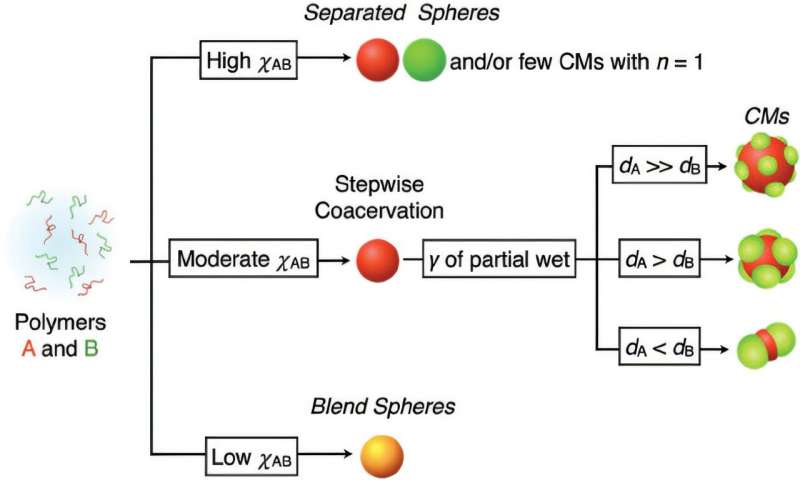Researchers at University of Tsukuba have discovered that colloidal molecules with specific symmetrical shapes, such as polyatomic molecules, are spontaneously formed through self-assembly via the assembling of a blend solution of two types of conjugated polymers into clusters of micrometer-scale polymer droplets.
The shapes of simple polyatomic molecules such as carbon dioxide and methane are characterized by a specific symmetry depending on the manner in which the atoms are linked. Nano- to micrometer-sized particles that mimic the shapes of such polyatomic molecules are referred to as colloidal molecules, which can form soft materials. However, conventionally synthesizing colloidal molecules with such specific symmetry requires a multi-step synthetic process.
In this study, published in the journal Small, researchers successfully demonstrated the bottom-up synthesis of colloidal molecules consisting of fluorescent polymers. They achieved this by blending two conjugated polymers in a solution and allowing them to self-assemble. Self-assembly involves the stepwise formation of polymer microdroplets.
One of the polymers formed the first droplet to serve as the core droplet, on which the other polymer subsequently formed satellite droplets, resulting in the formation of phase-separated droplet clusters. As the self-assembly proceeded, these droplet clusters grew while maintaining a symmetric shape similar to polyatomic molecules and then solidified to form colloidal molecules.
This entire self-assembly process is spontaneous. The researchers also discovered that colloidal molecules with various symmetries formed depending on the polymer mixing ratio.
A polymer solution forms micrometer-sized droplets via a liquid-liquid phase separation process. This study incorporated this process into the self-assembly of a synthetic polymer and synthesized fluorescent colloidal molecules solely through the polymer self-assembly, for the first time. By further controlling the assembly of the droplet clusters, higher-order colloidal assemblies can be formed, leading to the development of new polymer microphotonics materials.
More information:
Osamu Oki et al, Spontaneous Formation of π‐Conjugated Polymeric Colloidal Molecules Through Stepwise Coacervation and Symmetric Compartmentalization, Small (2024). DOI: 10.1002/smll.202404934
Journal information:
Small
Provided by
University of Tsukuba
Citation:
Spontaneous synthesis of colloidal molecules through polymer self-assembly successfully demonstrated (2024, October 24)
retrieved 24 October 2024
from https://phys.org/news/2024-10-spontaneous-synthesis-colloidal-molecules-polymer.html
This document is subject to copyright. Apart from any fair dealing for the purpose of private study or research, no
part may be reproduced without the written permission. The content is provided for information purposes only.

